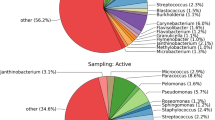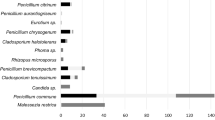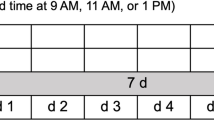Abstract
Inhalation of airborne fungi is known to cause respiratory illnesses such as allergies. However, the association between exposure and health outcomes remains largely unclear, in part due to lack of knowledge about fungal exposure in daily life. This study aims to introduce DNA-based methods such as high-throughput sequencing (HTS) and quantitative polymerase chain reaction (qPCR) to compare fungal microbiota and concentrations in indoor, outdoor, and personal air. Five sets of concurrent indoor, outdoor, and personal air samples were collected, each with duration of 4 days. Sequencing analysis revealed greater species richness in personal than indoor air for four out of the five sets, indicating that people are exposed to outdoor species that are not in indoor air. The personal–indoor (P/I) and personal–outdoor (P/O) ratios of total fungi were 1.2 and 0.15, respectively, suggesting that personal exposure to total fungi is better represented by indoor than outdoor concentrations. However, the ratios were taxon dependent, highlighting the complexity of generalizing personal exposure to the diverse kingdom Fungi. These results demonstrate that the HTS/qPCR method is useful for assessing taxon-specific fungal exposure, which might be difficult to achieve effectively using conventional, non-DNA-based techniques.






Similar content being viewed by others
References
Adams, R. I., Miletto, M., Taylor, J. W., & Bruns, T. D. (2013). Dispersal in microbes: Fungi in indoor air are dominated by outdoor air and show dispersal limitation at short distances. ISME Journal, 7, 1262–1273.
Adhikari, A., Reponen, T., Lee, S. A., & Grinshpun, S. A. (2004). Assessment of human exposure to airborne fungi in agricultural confinements: Personal inhalable sampling versus stationary sampling. Annals of Agricultural and Environmental Medicine, 11, 269–277.
Allen, J. G., McClean, M. D., Stapleton, H. M., Nelson, J. W., & Webster, T. F. (2007). Personal exposure to polybrominated diphenyl ethers (PBDEs) in residential indoor air. Environmental Science and Technology, 41, 4574–4579.
Altschul, S. F., Gish, W., Miller, W., Myers, E. W., & Lipman, D. J. (1990). Basic local alignment search tool. Journal of Molecular Biology, 215, 403–410.
Amend, A. S., Seifert, K. A., Samson, R., & Bruns, T. D. (2010). Indoor fungal composition is geographically patterned and more diverse in temperate zones than in the tropics. Proceedings of the National Academy of Sciences of the United States of America, 107, 13748–13753.
An, C., & Yamamoto, N. (2016). Fungal compositions and diversities on indoor surfaces with visible mold growths in residential buildings in the Seoul Capital Area of South Korea. Indoor Air, 26, 714–723.
Andersen, A. A. (1958). New sampler for the collection, sizing, and enumeration of viable airborne particles. Journal of Bacteriology, 76, 471–484.
Blankenberg, D., Von Kuster, G., Coraor, N., Ananda, G., Lazarus, R., Mangan, M., et al. (2010). Galaxy: A web-based genome analysis tool for experimentalists. Current Protocols in Molecular Biology, 19(10), 1–21.
Bolger, A. M., Lohse, M., & Usadel, B. (2014). Trimmomatic: A flexible trimmer for Illumina sequence data. Bioinformatics, 30, 2114–2120.
Buée, M., Reich, M., Murat, C., Morin, E., Nilsson, R. H., Uroz, S., et al. (2009). 454 Pyrosequencing analyses of forest soils reveal an unexpectedly high fungal diversity. New Phytologist, 184, 449–456.
Burge, H. A. (2002). An update on pollen and fungal spore aerobiology. Journal of Allergy and Clinical Immunology, 110, 544–552.
Caporaso, J., Kuczynski, J., Stombaugh, J., Bittinger, K., Bushman, F., Costello, E., et al. (2010). QIIME allows analysis of high-throughput community sequencing data. Nature Methods, 7, 335–336.
Cole, G. T., & Samson, R. A. (1984). The conidia. In Y. Al-Doory & J. F. Domson (Eds.), Mould allergy (pp. 66–104). Philadelphia: Lea & Fibiger.
Crous, P. W., Braun, U., & Groenewald, J. Z. (2007). Mycosphaerella is polyphyletic. Studies in Mycology, 58, 1–32.
Cruz-Perez, P., Buttner, M. P., & Stetzenbach, L. D. (2001). Specific detection of Stachybotrys chartarum in pure culture using quantitative polymerase chain reaction. Molecular and Cellular Probes, 15, 129–138.
Dannemiller, K., Lang-Yona, N., Yamamoto, N., Rudich, Y., & Peccia, J. (2014a). Combining real-time PCR and next-generation DNA sequencing to provide quantitative comparisons of fungal aerosol populations. Atmospheric Environment, 84, 113–121.
Dannemiller, K., Reeves, D., Bibby, K., Yamamoto, N., & Peccia, J. (2014b). Fungal high-throughput taxonomic identification tool for use with next-generation sequencing (FHiTINGS). Journal of Basic Microbiology, 54, 315–321.
Delfino, R. J., Zeiger, R. S., Seltzer, J. M., Street, D. H., Matteucci, R. M., Anderson, P. R., et al. (1997). The effect of outdoor fungal spore concentrations on daily asthma severity. Environmental Health Perspectives, 105, 622–635.
Denning, D. W., O’Driscoll, B. R., Hogaboam, C. M., Bowyer, P., & Niven, R. M. (2006). The link between fungi and severe asthma: A summary of the evidence. European Respiratory Journal, 27, 615–626.
Edgar, R. C., Haas, B. J., Clemente, J. C., Quince, C., & Knight, R. (2011). UCHIME improves sensitivity and speed of chimera detection. Bioinformatics, 27, 2194–2200.
Eduard, W., Douwes, J., Mehl, R., Heederik, D., & Melbostad, E. (2001). Short term exposure to airborne microbial agents during farm work: Exposure-response relations with eye and respiratory symptoms. Occupational and Environmental Medicine, 58, 113–118.
Elbert, W., Taylor, P. E., Andreae, M. O., & Pöschl, U. (2007). Contribution of fungi to primary biogenic aerosols in the atmosphere: Wet and dry discharged spores, carbohydrates, and inorganic ions. Atmospheric Chemistry and Physics, 7, 4569–4588.
Fröhlich-Nowoisky, J., Pickersgill, D. A., Després, V. R., & Pöschl, U. (2009). High diversity of fungi in air particulate matter. Proceedings of the National Academy of Sciences of the United States of America, 106, 12814–12819.
Gardes, M., & Bruns, T. D. (1993). ITS primers with enhanced specificity for Basidiomycetes: Application to the identification of mycorrhizae and rusts. Molecular Ecology, 2, 113–118.
George, B. J., Whitaker, D. A., Gilliam, R. C., Swall, J. L., & Williams, R. W. (2010). Relationship between PM2.5 collected at residential outdoor locations and a central site. Journal of the Air and Waste Management Association, 60, 1094–1104.
Giardine, B., Riemer, C., Hardison, R. C., Burhans, R., Elnitski, L., Shah, P., et al. (2005). Galaxy: A platform for interactive large-scale genome analysis. Genome Research, 15, 1451–1455.
Goecks, J., Nekrutenko, A., Taylor, J., & Team, T. G. (2010). Galaxy: A comprehensive approach for supporting accessible, reproducible, and transparent computational research in the life sciences. Genome Biology, 11, R86.
Guarro, J., & Gené, J. (1992). Fusarium infections. Criteria for the identification of the responsible species. Mycoses, 35, 109–114.
Haas, D., Habib, J., Luxner, J., Galler, H., Zarfel, G., Schlacher, R., et al. (2014). Comparison of background levels of culturable fungal spore concentrations in indoor and outdoor air in southeastern Austria. Atmospheric Environment, 98, 640–647.
Halonen, M., Stern, D. A., Wright, A. L., Taussig, L. M., & Martinez, F. D. (1997). Alternaria as a major allergen for asthma in children raised in a desert environment. American Journal of Respiratory and Critical Care Medicine, 155, 1356–1361.
Halstensen, A. (2008). Species-specific fungal DNA in airborne dust as surrogate for occupational mycotoxin exposure? International Journal of Molecular Sciences, 9, 2543–2558.
Hamada, N., & Abe, N. (2009). Physiological characteristics of 13 common fungal species in bathrooms. Mycoscience, 50, 421–429.
Hawksworth, D. L. (2001). The magnitude of fungal diversity: The 1.5 million species estimate revisited. Mycological Research, 105, 1422–1432.
Heald, C. L., & Spracklen, D. V. (2009). Atmospheric budget of primary biological aerosol particles from fungal spores. Geophysical Research Letters, 36, L09806.
Herrera, M. L., Vallor, A. C., Gelfond, J. A., Patterson, T. F., & Wickes, B. L. (2009). Strain-dependent variation in 18S ribosomal DNA copy numbers in Aspergillus fumigatus. Journal of Clinical Microbiology, 47, 1325–1332.
Horner, W. E., Helbling, A., Salvaggio, J. E., & Lehrer, S. B. (1995). Fungal allergens. Clinical Microbiology Reviews, 8, 161–179.
Hoseini, M., Jabbari, H., Naddafi, K., Nabizadeh, R., Rahbar, M., Yunesian, M., et al. (2013). Concentration and distribution characteristics of airborne fungi in indoor and outdoor air of Tehran subway stations. Aerobiologia, 29, 355–363.
Hospodsky, D., Yamamoto, N., & Peccia, J. (2010). Accuracy, precision, and method detection limits of quantitative PCR for airborne bacteria and fungi. Applied and Environmental Microbiology, 76, 7004–7012.
Kauffman, H. F., & van der Heide, S. (2003). Exposure, sensitization, and mechanisms of fungus-induced asthma. Current Allergy and Asthma Reports, 3, 430–437.
Klepeis, N. E., Nelson, W. C., Ott, W. R., Robinson, J. P., Tsang, A. M., Switzer, P., et al. (2001). The National Human Activity Pattern Survey (NHAPS): A resource for assessing exposure to environmental pollutants. Journal of Exposure Analysis and Environmental Epidemiology, 11, 231–252.
Kumari, P., Woo, C., Yamamoto, N., & Choi, H.-L. (2016). Variations in abundance, diversity and community composition of airborne fungi in swine houses across seasons. Scientific Reports, 6, 37929.
Lee, S.-A., Adhikari, A., Grinshpun, S. A., McKay, R., Shukla, R., & Reponen, T. (2006a). Personal exposure to airborne dust and microorganisms in agricultural environments. Journal of Occupational and Environmental Hygiene, 3, 118–130.
Lee, S., An, C., Xu, S., Lee, S., & Yamamoto, N. (2016). High-throughput sequencing reveals unprecedented diversities of Aspergillus species in outdoor air. Letters in Applied Microbiology, 63, 165–171.
Lee, T., Grinshpun, S. A., Martuzevicius, D., Adhikari, A., Crawford, C. M., & Reponen, T. (2006b). Culturability and concentration of indoor and outdoor airborne fungi in six single-family homes. Atmospheric Environment, 40, 2902–2910.
Lee, S.-A., & Liao, C.-H. (2014). Size-selective assessment of agricultural workers’ personal exposure to airborne fungi and fungal fragments. Science of the Total Environment, 466–467, 725–732.
Lee, S., & Yamamoto, N. (2015). Accuracy of the high-throughput amplicon sequencing to identify species within the genus Aspergillus. Fungal Biology, 119, 1311–1321.
Li, X.-G., Ding, C.-F., Zhang, T.-L., & Wang, X.-X. (2014). Fungal pathogen accumulation at the expense of plant-beneficial fungi as a consequence of consecutive peanut monoculturing. Soil Biology & Biochemistry, 72, 11–18.
Licina, D., Tian, Y., & Nazaroff, W. W. (2017). Emission rates and the personal cloud effect associated with particle release from the perihuman environment. Indoor Air. doi:10.1111/ina.12365.
Madsen, A. M. (2006). Exposure to airborne microbial components in autumn and spring during work at Danish biofuel plants. Annals of Occupational Hygiene, 50, 821–831.
Mark, D., & Vincent, J. H. (1986). A new personal sampler for airborne total dust in workplaces. Annals of Occupational Hygiene, 30, 89–102.
McCartney, H. A., Schmechel, D., & Lacey, M. E. (1993). Aerodynamic diameter of conidia of Alternaria species. Plant Pathology, 42, 280–286.
McDonagh, A., & Byrne, M. A. (2014). A study of the size distribution of aerosol particles resuspended from clothing surfaces. Journal of Aerosol Science, 75, 94–103.
Mendell, M. J., Mirer, A. G., Cheung, K., Tong, M., & Douwes, J. (2011). Respiratory and allergic health effects of dampness, mold, and dampness-related agents: A review of the epidemiologic evidence. Environmental Health Perspectives, 119, 748–756.
Milstone, L. M. (2004). Epidermal desquamation. Journal of Dermatological Science, 36, 131–140.
Mitakakis, T. Z., Tovey, E. R., Xuan, W., & Marks, G. B. (2000). Personal exposure to allergenic pollen and mould spores in inland New South Wales, Australia. Clinical and Experimental Allergy, 30, 1733–1739.
Mitchell, J. I., & Zuccaro, A. (2006). Sequences, the environment and fungi. Mycologist, 20, 62–74.
Nilsson, R. H., Bok, G., Ryberg, M., Kristiansson, E., & Hallenberg, N. (2009). A software pipeline for processing and identification of fungal ITS sequences. Source Code for Biology and Medicine, 4, 1.
O’Donnell, K., Gueidan, C., Sink, S., Johnston, P. R., Crous, P. W., Glenn, A., et al. (2009). A two-locus DNA sequence database for typing plant and human pathogens within the Fusarium oxysporum species complex. Fungal Genetics and Biology, 46, 936–948.
O’Brien, H. E., Parrent, J. L., Jackson, J. A., Moncalvo, J. M., & Vilgalys, R. (2005). Fungal community analysis by large-scale sequencing of environmental samples. Applied and Environmental Microbiology, 71, 5544–5550.
O’Donnell, K., & Cigelnik, E. (1997). Two divergent intragenomic rDNA ITS2 types within a monophyletic lineage of the fungus Fusarium are nonorthologous. Molecular Phylogenetics and Evolution, 7, 103–116.
Palmgren, U., Ström, G., Blomquist, G., & Malmberg, P. (1986). Collection of airborne micro-organisms on Nuclepore filters, estimation and analysis—CAMNEA method. Journal of Applied Bacteriology, 61, 401–406.
Pasanen, A. L. (2001). A review: Fungal exposure assessment in indoor environments. Indoor Air, 11, 87–98.
Peccia, J., & Hernandez, M. (2006). Incorporating polymerase chain reaction-based identification, population characterization, and quantification of microorganisms into aerosol science: A review. Atmospheric Environment, 40, 3941–3961.
Pringle, A. (2013). Asthma and the diversity of fungal spores in air. PLoS Pathogens, 9, e1003371.
Schloss, P. D., Westcott, S. L., Ryabin, T., Hall, J. R., Hartmann, M., Hollister, E. B., et al. (2009). Introducing mothur: Open-source, platform-independent, community-supported software for describing and comparing microbial communities. Applied and Environmental Microbiology, 75, 7537–7541.
Shelton, B. G., Kirkland, K. H., Flanders, W. D., & Morris, G. K. (2002). Profiles of airborne fungi in buildings and outdoor environments in the United States. Applied and Environmental Microbiology, 68, 1743–1753.
Shinohara, N., Kumagai, K., Yamamoto, N., Yanagisawa, Y., Fujii, M., & Yamasaki, A. (2004). Field validation of an active sampling cartridge as a passive sampler for long-term carbonyl monitoring. Journal of the Air and Waste Management Association, 54, 419–424.
Simon-Nobbe, B., Denk, U., Pöll, V., Rid, R., & Breitenbach, M. (2008). The spectrum of fungal allergy. International Archives of Allergy and Immunology, 145, 58–86.
Takahashi, T. (1997). Airborne fungal colony-forming units in outdoor and indoor environments in Yokohama, Japan. Mycopathologia, 139, 23–33.
Taylor, J. E., Groenewald, J. Z. E., & Crous, P. W. (2003). A phylogenetic analysis of Mycosphaerellaceae leaf spot pathogens of Proteaceae. Mycological Research, 107, 653–658.
Tedersoo, L., Bahram, M., Põlme, S., Kõljalg, U., Yorou, N. S., Wijesundera, R., et al. (2014). Global diversity and geography of soil fungi. Science, 346, 1256688.
Vesper, S. (2011). Traditional mould analysis compared to a DNA-based method of mould analysis. Critical Reviews in Microbiology, 37, 15–24.
White, T. J., Bruns, T., Lee, S., & Taylor, J. (1990). Amplification and direct sequencing of fungal ribosomal RNA genes for phylogenetics. In M. A. Innis, D. H. Gelfand, J. J. Sninsky, & T. J. White (Eds.), PCR protocols a guide to methods and applications (pp. 315–322). San Diego: Academic.
Williams, R. O. N., Suggs, J., Zweidinger, R., Evans, G., Creason, J., Kwok, R., et al. (2000). The 1998 Baltimore Particulate Matter Epidemiology-Exposure Study: Part 1. Comparison of ambient, residential outdoor, indoor and apartment particulate matter monitoring. Journal of Exposure Analysis and Environmental Epidemiology, 10, 518–532.
Wu, Z., Blomquist, G., Westermark, S.-O., & Wang, X.-R. (2002). Application of PCR and probe hybridization techniques in detection of airborne fungal spores in environmental samples. Journal of Environmental Monitoring, 4, 673–678.
Yamamoto, N., & Bibby, K. (2014). Clustering of fungal community internal transcribed spacer sequence data obscures taxonomic diversity. Environmental Microbiology, 16, 2491–2500.
Yamamoto, N., Bibby, K., Qian, J., Hospodsky, D., Rismani-Yazdi, H., Nazaroff, W. W., et al. (2012). Particle-size distributions and seasonal diversity of allergenic and pathogenic fungi in outdoor air. ISME Journal, 6, 1801–1811.
Yamamoto, N., Hospodsky, D., Dannemiller, K., Nazaroff, W. W., & Peccia, J. (2015a). Indoor emissions as a primary source of airborne allergenic fungal particles in classrooms. Environmental Science and Technology, 49, 5098–5106.
Yamamoto, N., Matsuki, H., & Yanagisawa, Y. (2007). Application of the personal aeroallergen sampler to assess personal exposures to Japanese cedar and cypress pollens. Journal of Exposure Science & Environmental Epidemiology, 17, 637–643.
Yamamoto, N., Matsuki, Y., Yokoyama, H., & Matsuki, H. (2015b). Relationships among indoor, outdoor, and personal airborne Japanese cedar pollen counts. PLoS ONE, 10, e0131710.
Yamamoto, N., Nazaroff, W. W., & Peccia, J. (2014). Assessing the aerodynamic diameters of taxon-specific fungal bioaerosols by quantitative PCR and next-generation DNA sequencing. Journal of Aerosol Science, 78, 1–10.
Yamamoto, N., Shendell, D. G., & Peccia, J. (2011). Assessing allergenic fungi in house dust by floor wipe sampling and quantitative PCR. Indoor Air, 21, 521–530.
Yang, W., Lee, K., Yoon, C., Yu, S., Park, K., & Choi, W. (2011). Determinants of residential indoor and transportation activity times in Korea. Journal of Exposure Science & Environmental Epidemiology, 21, 310–316.
Yao, M., & Mainelis, G. (2007). Analysis of portable impactor performance for enumeration of viable bioaerosols. Journal of Occupational and Environmental Hygiene, 4, 514–524.
Yuill, E. (1950). The numbers of nuclei in conidia of Aspergilli. Transactions of the British Mycological Society, 33, 324–331.
Zhou, B., Zhao, B., & Tan, Z. (2011). How particle resuspension from inner surfaces of ventilation ducts affects indoor air quality—A modeling analysis. Aerosol Science and Technology, 45, 996–1009.
Acknowledgements
This work was supported by the Aspiring Researcher Program through Seoul National University in 2014.
Author information
Authors and Affiliations
Corresponding author
Ethics declarations
Conflict of interest
The authors declare that they have no conflicts of interest.
Electronic supplementary material
Below is the link to the electronic supplementary material.
Rights and permissions
About this article
Cite this article
An, C., Woo, C. & Yamamoto, N. Introducing DNA-based methods to compare fungal microbiota and concentrations in indoor, outdoor, and personal air. Aerobiologia 34, 1–12 (2018). https://doi.org/10.1007/s10453-017-9490-6
Received:
Accepted:
Published:
Issue Date:
DOI: https://doi.org/10.1007/s10453-017-9490-6




